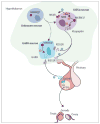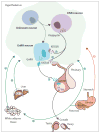Pubertal development and regulation
- PMID: 26852256
- PMCID: PMC5192018
- DOI: 10.1016/S2213-8587(15)00418-0
Pubertal development and regulation
Abstract
Puberty marks the end of childhood and is a period when individuals undergo physiological and psychological changes to achieve sexual maturation and fertility. The hypothalamic-pituitary-gonadal axis controls puberty and reproduction and is tightly regulated by a complex network of excitatory and inhibitory factors. This axis is active in the embryonic and early postnatal stages of life and is subsequently restrained during childhood, and its reactivation culminates in puberty initiation. The mechanisms underlying this reactivation are not completely known. The age of puberty onset varies between individuals and the timing of puberty initiation is associated with several health outcomes in adult life. In this Series paper, we discuss pubertal markers, epidemiological trends of puberty initiation over time, and the mechanisms whereby genetic, metabolic, and other factors control secretion of gonadotropin-releasing hormone to determine initiation of puberty.
Copyright © 2016 Elsevier Ltd. All rights reserved.
Conflict of interest statement
Declaration of interests UBK has received personal fees from Takeda, unrelated to this work. APA declares no competing interests.
Figures



References
-
- Terasawa E, Fernandez DL. Neurobiological mechanisms of the onset of puberty in primates. Endocr Rev. 2001;22:111–51. - PubMed
-
- Kuiri-Hänninen T, Sankilampi U, Dunkel L. Activation of the hypothalamic-pituitary-gonadal axis in infancy: minipuberty. Horm Res Paediatr. 2014;82:73–80. - PubMed
-
- Kaprio J, Rimpelä A, Winter T, et al. Common genetic influences on BMI and age at menarche. Hum Biol. 1995;67:739–53. - PubMed
Publication types
MeSH terms
Substances
Grants and funding
LinkOut - more resources
Full Text Sources
Other Literature Sources
Medical

